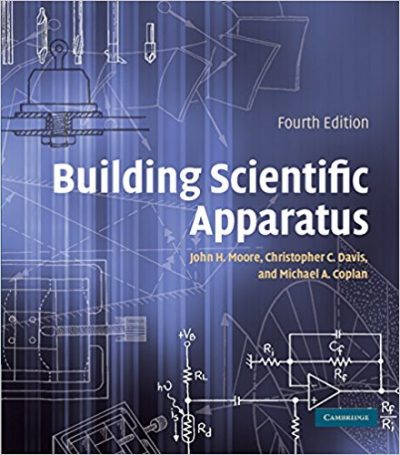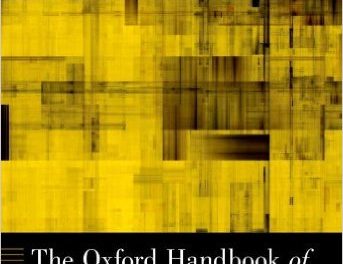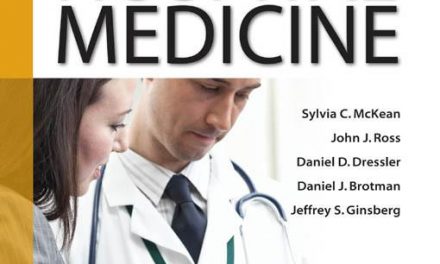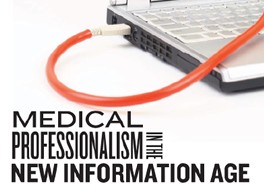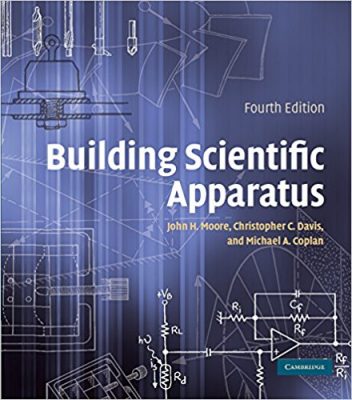 Authors: John H. Moore, Christopher C. David, and Michael A. Coplan
Authors: John H. Moore, Christopher C. David, and Michael A. Coplan
Publisher: Cambridge University Press – 647 pages
Book Review by: Sonu Chandiram
If you want to learn how to gain an understanding of various types of scientific equipment, and are ready to construct and use it, this is the book to have. Spanning over nearly 650 pages, it covers a wide range of subjects within the general heading of science and the scientific method of exploration and 3perimentation.
You will discover the very wide-ranging coverage as you look through its Contents page, but to give you a brief overview of what is in it, we list the titles of its eight chapters here:
- Mechanical Design and Fabrication
- Working with Glass
- Vacuum Technology
- Optical Systems
- Charged-Particle Optics
- Electronics
- Detections
- Measurement and Control of Temperature
This book has been written for use by students, teachers, and practitioners in the various fields of science, particularly biological, chemical, and physical sciences and engineering.
The book does much, and here below are some of its key functions. It provides:
- Explanation of the physical principles that you must grasp to make useful and creative decisions in the design of scientific apparatus
- Description of the skills – such as circuit analysis, matrix methods, mechanical drawing, and optical ray-tracing – required to design an instrument
- Definition of parameters used by manufacturers for each class of components: electrical, glass, mechanical, optical, thermal, and others.
- Discussion of useful materials and components, such as infrared detectors, metal alloys, operational amplifiers, and optical materials
- Consideration in considerable detail of basic laboratory skills needed in building scientific instruments, such as: blowing glass, brazing (joining) metals and other materials, soldering electrical equipment, and polishing your finished product
- Overview of operations like: casting, laser-cutting, lathe turning, milling, and printed-circuit production (which one might get done outside)
- Understanding the capabilities and limitations of shop processes that are necessary in designing and building a scientific device or instrument.
The chapters in this book provide a lot of discussion and illustration of detail employing text and drawings. Let’s take a look inside chapter 4 – Optical Systems – to get an idea. The topics covered include the ones named below (but there are also various subtopics discussed within each topic):
- 1 – Optical Terminology
- 2 – Characterization and Analysis of Optical Systems
- 3 – Optical Components
- 4 – Optical Materials
- 5 – Optical Sources
- 6 – Lasers
- 7 – Optical Dispersing Instruments
Numerous Endnotes and Cited References are provided at the end of this chapter, and others, to help you explore each topic and subtopic further.
This book provides a wealth of technical information but it is written in language accessible to non-technical people as well. It is no doubt a popular book, as evidenced by the fact that it is now in its fourth edition. Science will continue to play a larger and moré significant role in all our lives, and the main reason is that it shows us what is real and factual. This is only possible with the use of scientific apparatus.
This book shows you how to design and build various scientific instruments that are so critical to measure the many aspects of the environment that surrounds us. What could be more important in our lives than for us to live safely?
Authors:
John H. Moore is Professor Emeritus at the University of Maryland. He is a Fellow of the American Physical Society and the American Association for the Advancement of Science. His research has included the design and fabrication of instruments for use in the laboratory and on spacecraft, high-energy electron scattering, and plasma chemistry.
Christopher C. David is Professor of Electrical and Computer Engineering at the University of Maryland. He is a Fellow of the Institute of Physics, and of the Institute of Electrical and Electronic Engineers. His research has dealt with free space optical and directional RF communication systems, plasmonics, near-field scanning and optical microscopy, chemical and biological sensors, interferometer, optical systems, bio-electromagnetics, and RF dosimetry.
Michael A. Coplan is Professor and Director of the Chemical Physics Program at the University of Maryland. He is a Fellow of the American Physical Society and has research programs in space science, electron scattering, and neutron detection.
With a chapter by:
Sandra Greer, who is a Professor Emerita of Chemistry and Biochemistry, and a Professor of Chemical and Biomolecular Engineering at the University of Maryland, and is now Provost and Dean of the Faculty at Mills College in Oakland, California. She is a Fellow of the American Physical Society and the American Association for the Advancement of Science, and a recipient of the American Chemical Society Francis P. Garvan-John M. Olin Medal.

